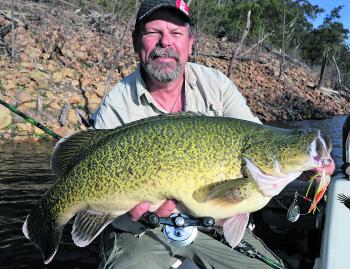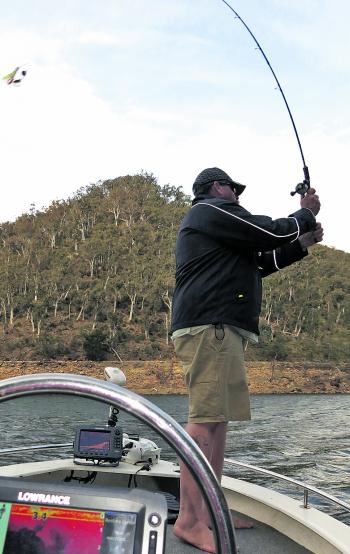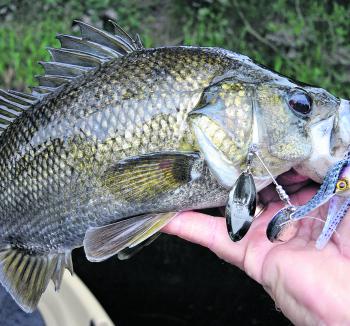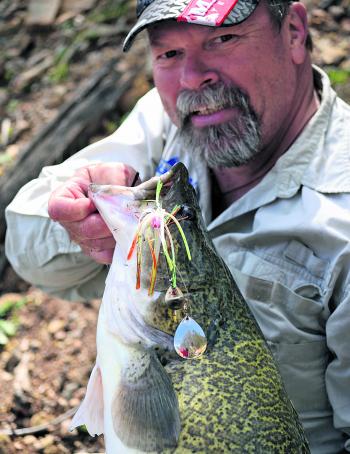Spinnerbaits are unusual lures that can be deadly on all manner of freshwater fish, as well as quite a few living in the salt. Here’s a basic primer on how to use them.
Spinnerbaits are strange-looking contraptions. They consist of a wire arm formed into a shape similar to a coat hanger, with a spoon-like blade or blades rotating on the end of one arm and a lead-headed jig fixed at the other end. This jighead usually carries a skirt, consisting of a collar of shredded rubber or plastic strands. The skirt hangs behind the jighead, over and around one or more single, upward-facing hooks.
Mostly used in freshwater, spinnerbaits are particularly effective on Australian bass, Murray cod, golden perch (yellowbelly) and saratoga. They’ll also tempt barra (on occasions) as well as sooty grunter and jungle perch. Smaller versions catch trout and redfin perch.
Spinnerbaits can also be effective in saltwater, especially on flathead, estuary cod, coral trout and even mulloway, but their components may corrode when they’re exposed to saltwater. If you use a spinnerbait in the salt, wash and dry it afterwards.
Because of their unique design — with the upward-facing hooks shielded by the wire frame — spinnerbaits are surprisingly snag-resistant and can be thrown into dense cover (especially timber and rock) with only an occasional hang-up. This is one reason they’re such a deadly choice on bass and cod living among structure.
Spinnerbait blades come in different shapes. The most common are Colorado, Indiana and willow. Colorado blades are rounded, like the bowl of a soup spoon, while Indiana and willow blades are progressively longer and thinner. Spinnerbaits with two or more blades often carry a mix of different shapes. There are also spinnerbaits with extra arms and blades, including doubles and quads, as well as some featuring unusual blade designs, such as ‘hatchet’ blades.
Most anglers feel that rounded Colorado blades have a stronger action, more flash, and create a larger ‘sonic signature,’ especially at slower speeds. The downside is that spinnerbaits with Colorado blades tend to ride up in the water column through the retrieve. Thinner profile blades need a slightly higher retrieve speed to spin well, but also track a little deeper than Colorados.
Some spinnerbaits come with a soft plastic ‘trailer’ factory-fitted to their hook, and others may also carry a second ‘stinger’ hook, usually linked or ganged to the main hook. Many keen anglers also add these items as after-market tweaks. However, it can be tricky to add both a trailer and a stinger without causing constant tangling.
Stinger hooks are a popular choice among tournament anglers, who can’t afford to miss too many strikes. Whether or not they’re needed depends on the fish you’re targeting and how they’re striking on the day.
Stingers can be fitted in a number of ways: either semi-stiff or swinging. To rig a semi-stiff stinger, slip a short length of plastic tubing over the eye of the stinger hook before skewering the point of the spinnerbait’s hook through the tubing and stinger hook eye. Swinging stingers are simply slipped over the existing hook via their eye and a length of tubing or bead added to the spinnerbait hook to prevent the stinger working free. Both approaches have advantages and drawbacks. Try both and discover which you prefer.
Stingers are almost always rigged facing upwards, in the same plane as the fixed jig hook. Ideal patterns include Siwash-style hooks with rounded-bends and no offset. Those sold specifically for this purpose have an over-sized, round eye to aid rigging.
The trade-off with any stinger is the fact that it will result in a few more snags, as well as some tangles when casting. You need to decide if the extra hassle is justified in terms of increased hookups.
There’s nothing fancy about most spinnerbait retrieves. Cast the lure out and let it sink to the desired depth (often the bottom), then commence with a couple of fast turns of the reel to get the blades rotating before slowing down a little. You’ll clearly feel the resistance and throb of the twirling blades, especially through braided line. In deeper areas you may wish to pause once or twice during the retrieve and allow the spinnerbait to sink again. Apart from that, clever rod and reel work is generally unnecessary: simply cast and crank!
Spinnerbaits can also be trolled, and this approach is growing in popularity.
No matter where you live, chances are there’s a fish swimming nearby that will happily smack a spinnerbait. If you haven’t tried these oddball lures yet, this summer might be the ideal time to literally give one a ‘whirl’!
To watch me catch my ‘PB’ Murray cod on a spinnerbait, scan the QR code hereabouts or go to: www.youtube.com/watch?v=9Qq1I1m0PLE.
Reads: 12613
Murray cod are a prime species to target when casting spinnerbaits.

While spinnerbaits are mostly cast-and-retrieved, they can also be slow trolled.

Aussie bass love spinnerbaits!





